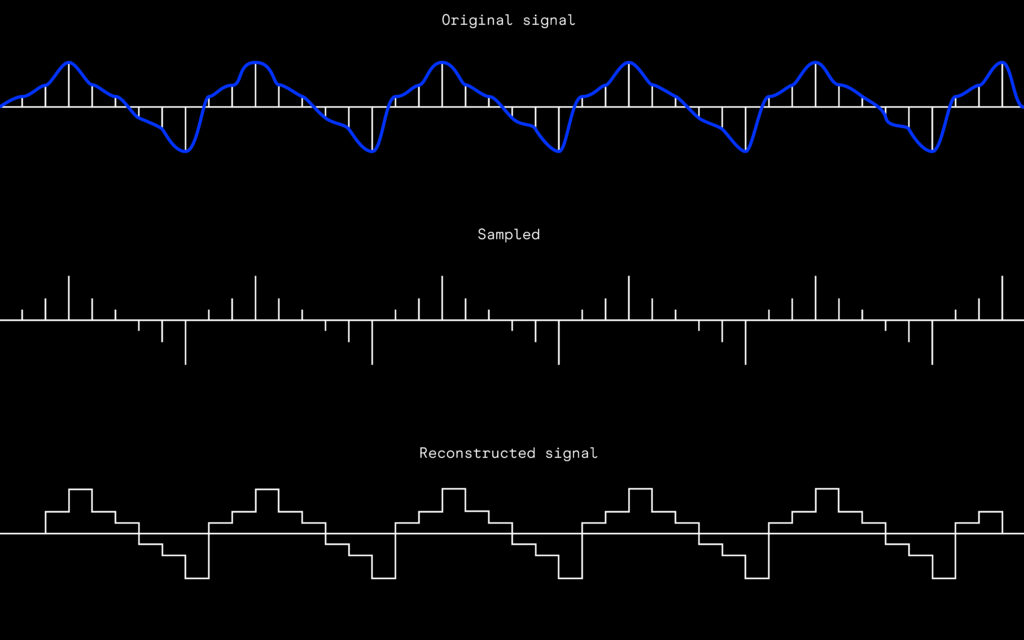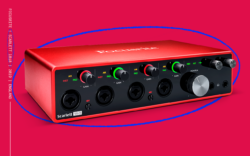Illustration: Islenia Milien
Analog-to-digital conversion often happens behind the scenes, but it’s vital to how we create and communicate with sound.
Every time you talk into your smartphone or record audio into your laptop, physical sound waves are being measured and translated into binary data that a computer can both understand and make changes to. Let’s explore just how the technique of analog-to-digital conversion has completely redefined our approach to music in the modern era.
Analog and digital: what’s the difference?
The concept of analog-to-digital conversion came about in the 20th century along with the development of telephones and computers. We began relying less on largely analog or mechanical technology and instead moved towards the storage and transmission of data as digital signals. This was the beginning of the Information Age (and it doesn’t seem to show any signs of slowing down)!
But what separates the analog from the digital? An analog signal is continuous, like the human voice, a violin, or a record played on a turntable. These signals are created by physical vibrations or electrical circuits. Digital signals, on the other hand, are discrete and thus have a very limited set of values they can represent at very specific points in time. This means that, while continuous analog signals are the most ‘accurate,’ they’re also noisier and harder to store without degrading over time, while a digital signal can be recorded once and never decrease in quality. In fact, one of the biggest impacts digital technology had on music can be seen in the huge shift from analog playback formats like vinyl records and cassette tapes to CDs (which use lasers to read digital signals) and eventually files like .mp3s.
How analog-to-digital conversion works
Ironically, the first step in converting an analog sound wave into digital audio data is using a type of analog device called a transducer. Microphones are transducers because they help change one type of energy into another through a special component called a diaphragm. The diaphragm will begin vibrating in response to incoming sound waves, which creates an alternating electrical current in the microphone. This AC voltage is its own analog signal, but one that can be passed through an ADC, or an analog-to-digital converter.
This is where things start to get really fun. An ADC takes an analog signal that’s continuous in both time and amplitude, and translates it into a series of numbers that most accurately represent its amplitude (how loud it is) at very specific points in time. It does this by taking a snapshot of the analog signal every so often – this is actually called sampling, and the amount of snapshots being taken is determined by sample rate. If we take the consumer audio standard of 44.1 kHz, that means the amplitude of the incoming signal was sampled and stored over 44,000 times every single second!
As each snapshot is taken based on the sample rate, the amplitude represented by that incoming electrical current needs to be measured and stored digitally through the process of quantization. This measurement isn’t perfect, since we once again only have a discrete amount of values to work with. The bit resolution (or bit depth) determines the range of values that can be used to represent amplitude in digital terms. Higher bit resolution results in less quantization error, which occurs when analog amplitudes and their digital representations don’t quite match up (this is why audio recorded at 8-bit resolutions can sound quite noisy). When combined, sample rate and bit resolution help determine the accuracy and overall quality of a fully converted digital audio signal.

Discrete and digital
Once all of this sampled amplitude data is encoded as a sequence of binary values, the process is complete! We now have a digital representation of an analog signal, which can be copied and transmitted an infinite number of times without any loss in quality. This data is commonly stored as an uncompressed audio file like .wav or .aiff, which makes it great for use in further audio processing or music production. Analog-to-digital converters can be found in a lot of modern electronics, from laptops to smartphones to pretty much any device you can activate with your voice. Standalone hardware audio interfaces function as high-quality ADC converters with multiple inputs, and this makes them invaluable for any serious music production setup. The sheer portability of all these devices has helped change the notion of what a ‘music studio’ can be in the modern age – and the shift from analog to digital means we can now create live recordings with almost no restrictions.
Explore royalty-free one-shots, loops, FX, MIDI, and presets from leading artists, producers, and sound designers:
July 23, 2020

.svg)
.svg)




